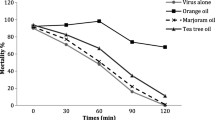Abstract
Among the major oil palm pest insects in the Côte d'Ivoire,Latoia viridissima Holland [Lepidoptera, Limacodidae] is the most frequently observed defoliator. During a pullulation of this species, a natural epizootic permitted us to demonstrate the occurrence of a small isometric RNA virus of 30nm in diameter. The buoyant density of the virus particles was 1.34. The virus capsid contained 2 major proteins with molecular weights of 30,000 (55%) and 31,000 (20%) and 3 minor proteins. One genome component was detected with molecular weight 2,9×106. Agarose gel diffusion tests showed this virus was distinct from any other described insect Picornavirus.
Trials with different doses of viral suspensions were tested on industrial oil palm plantation, allocated byL. viridissima, from ground level, using an automatic air carried sprayer. One week after the treatment, a mortality gradient, increasing from 11 to 61% according to the dose applied, was obtained. Two weeks after the treatment the mortality reached 92% of the larvae in the treated parcels. During the next generation, the number of caterpillars on the same parcel was very low.
Résumé
Parmi les principaux insectes ravageurs du palmier à huile en Côte d'Ivoire,Latoia viridissima Holland [Lepidoptera, Limacodidae] est le défoliateur le plus couramment observé. Lors d'une pullulation de cette espèce une épizootie nous a permis de mettre en évidence un petit virus icosaédrique à ARN de 30 nm de diamètre. La densité apparente de la particule virale est de 1,34. La composition polypeptidique du virus consiste en 2 protéines majeures de faible poids moléculaire 30 000 (55%) et 31 000 (20%) et en 3 protéines mineures. Le génome viral est constitué d'un fragment d'ARN dont le poids moléculaire est estimé à 2,9·106. Des tests d'immunodiffusion en gel d'agarose montrent que ce virus est distinct des autres Picornavirus d'insectes connus.
Des essais de traitements terrestres ont été menés sur une plantation industrielle de palmiers à huile envahie parL. viridissima, avec différentes doses de suspension virale en utilisant un pulvérisateur automatique porté. Il est intéressant de noter une semaine après le traitement un gradient de mortalité augmentant de 11 à 61% selon la sose utilisée. Deux semaines après le traitement l'épizootie causa la mort de 92% des larves sur la parcelle traitée. Le nombre de chenilles durant la génération suivante sur cette parcelle fut presque nul.
Similar content being viewed by others
References
Eaton, B. T. &Steacie, A. D. — 1980. Cricket Paralysis Virus RNA, a 3′ terminal poly (A.). —J. gen. virol., 50, 167–171.
Entwistle, P. F. — 1983. Control of insects by virus diseases. —Biocontrol News & Inform., 4, 203–229.
Fediere, G. — 1983. Recherches sur des viroses épizootiques de LépidoptèresLimacodidae ravageurs de palmacées. —Thèse Doct. 3 e cycle USTL, Montpellier, 130 pp.
Genty, P. &Mariau, D. — 1975. Utilisation d'un germe entomopathogène dans la lutte contreSibine fusca [Limacodidae]. —Oléagineux, 30, 349–354.
Giles, K. W. &Myers, A. — 1965. An improved Diphenylamine method for the estimation of deoxyribonucleic acid. —Nature, 206, 93.
Ginting, C. &Desmier de Chenon, R. — 1987. Nouvelles perspectives biologiques pour le contrôle d'un ravageur très important du cocotier en Indonésie:Parasa lepida [Limacodidae] —Oléagineux, 42, 107–118.
Hilz, H., Wiegers, U. &Adamietz, P. — 1975. Stimulation of Proteinase K action by denaturing agents: application to the isolation of nucleic acids and the degradation of “washed” proteins. —Eur. J. Biochem., 56, 103–108.
Jousset, F. X., Bergoin, M. &Revet, B. — 1977. Characterization of theDrosophila C Virus. —J. gen. virol., 34, 269–285.
Mariau, D., Desmier de Chenon, R., Julia, J. F. &Philippe, R. — 1981. Les ravageurs du palmier à huile et du cocotier en Afrique Occidentale. —Oléagineux, 36, 168–228.
Matthews, R. E. F. — 1982. Classification and nomenclature of viruses. —Intervirology, 17, 1–199.
Mejbaum, M. Z. — 1929. Uber die Bestimmung kleiner Pentosemengen, Insbesonder in Derivaten der Adenylsaüre. —Z. physiol. chem., 258, 117–120.
Ouchterlony, O. — 1948. Antigen antibody reaction in gels. —Ark. Keminer. Geol. B., 26, 16.
Payne, C. C. — 1982. Insect viruses as control agents. —Parasitology, 84, 35–77.
Peacock, A. C. &Dingman, C. W. — 1968. Molecular weight estimation and separation of ribonucleic acid by electrophoresis in agarose acrylamide composite gels. —Biochemistry, 7, 668–674.
Rowlands, D. J., Sangar, D. V. &Brown, F. — 1971. Buoyant density of picornavirus in caesium salts. —J. gen. virol., 13, 141–152.
Weber, K. &Osborn, M. — 1969. The reliability of molecular weight determination by dodecyl sulphate polyacrylamide gel electrophoresis. —J. Biol. Chem., 244, 4406–4412.
Author information
Authors and Affiliations
Rights and permissions
About this article
Cite this article
Fedière, G., Philippe, R., Veyrunes, J.C. et al. Biological control of the oil palm pestLatoia viridissima [Lepidoptera, limacodidae], in Cote d'Ivoire, by a new picornavirus. Entomophaga 35, 347–354 (1990). https://doi.org/10.1007/BF02375258
Received:
Accepted:
Issue Date:
DOI: https://doi.org/10.1007/BF02375258




